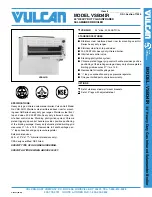
43
WHL-032 REV. 6.2.16
E. CH PRESSURE RELIEF VALVE
An external pressure relief valve is provided with this boiler. The pressure relief valve MUST BE
installed. When installing, observe the following guidelines. The pressure relief valve must be
installed as close to the boiler as possible. No other valves should be placed between the pressure
relief valve and the boiler. Failure to comply with these guidelines can result in substantial property
damage, personal injury, or death.
This boiler has a high-temperature shut-off switch built in as a standard safety feature. Therefore, a
“pressure only” relief valve is required. DO NOT operate this boiler before the supplied pressure
relief valve is installed with sufficient relieving capacity in accordance with the ASME rating plate
on the boiler.
CH Loop
This boiler is provided with a CH pressure relief valve that complies with the ANSI/ASME Boiler
and Pressure Vessel Code, Section IV (Heating Boilers). The included 30 psi CH Pressure Relief
Valve must be installed on the CH supply line to ensure a compliant installation and safe operation.
Westinghouse has supplied fittings to aid installation of the CH Pressure Relief Valve. The valve is
meant to be field installed. DO NOT install a CH pipe line relief valve with a pressure rating greater
than 30 psi. This is the maximum allowable CH relief valve setting for this boiler.
To avoid water damage or scalding due to relief valve operation:
Discharge line must be connected to relief valve outlet and run to a safe place of disposal. Terminate the discharge line in a
manner that will prevent possibility of severe burns or property damage should the relief valve discharge.
Discharge line must be as short as possible and the same size as the valve discharge connection throughout its entire length.
Discharge line must pitch downward from the valve and terminate at least 6” above the floor drain, making discharge clearly
visible.
The relief line cannot be in contact with any live electrical parts.
Discharge line shall terminate plain, not threaded, with a material serviceable for temperatures of 375
o
F or greater.
Do not pipe discharge to any location where freezing could occur.
No shutoff valve may be installed between the relief valve and boiler or in the discharge line. Do not plug or place any
obstruction in the discharge line.
Test the operation of the relief valve after filling and pressurizing the system by lifting the lever. Make sure the valve
discharges freely. If the valve fails to operate correctly, replace it with a new relief valve.
Test relief valve at least once annually to ensure the waterway is clear. If valve does not operate, turn the boiler
“off”
and call
a plumber immediately.
Take care whenever operating relief valve to avoid scalding injury or property damage.
For boilers installed with only a pressure relief valve, the separate storage vessel must have a temperature and pressure relief
valve installed. This relief valve shall comply with
Relief Valves for Hot Water Supply Systems, ANSI Z21.22 CSA4.4.
FAILURE TO COMPLY WITH THE ABOVE GUIDELINES COULD RESULT IN FAILURE OF RELIEF VALVE OPERATION,
RESULTING IN POSSIBILITY OF SUBSTANTIAL PROPERTY DAMAGE, SEVERE PERSONAL INJURY, OR DEATH.
F. BUILT-IN LOW WATER CUT-OFF (LWCO)
NOTE:
This boiler is equipped with a low water cut-off (LWCO) probe.
When this LWCO senses low water level, boiler operation will cease
and Er:80 will appear on the display panel. Er:80 will clear and boiler
operation will resume when the low water condition is remedied. Local
codes or jurisdictions may accept this control function as a means of
providing low water protection.
G. OPTIONAL EXTERNAL UL353 MANUAL RESET LOW
WATER CUT-OFF (LWCO) INTERFACE KIT
Westinghouse offers an optional External UL 353 Manual Reset Low
Water Cut-Off (LWCO) Interface Kit if a UL 353 LWCO is required by
local codes. The LWCO should be mounted into a tee as detailed in
Figure 31. It should then be wired into the boiler as described in Figure
32. Remove the jumper from the LWCO relay connection when
installing.
Follow the complete instructions included in the kit for proper
installation.
Figure 31
– Relief Valve Details
Figure 30
– Pressure Relief
Valve
















































